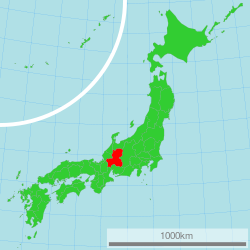Search Jobs
Sorry, we couldn't find any results.
Please try different search terms.
 During the Meiji Restoration Gifu was made from Hida and Mino provinces, as well as small parts of Echizen and Shinano provinces. Gifu was a long-term residence of Oda Nobunaga who during his campaign to unify Japan named it Gifu City after Qishan (a legendary mountain from which China was unified) and Qufu (the birthplace of Confucious). Historically, Gifu has been a crossroads and it had been said, " Control Gifu and you control Japan." Today it has a population of nearly 2.1 million with just over 400,000 of these people residing in the capital of Gifu City. The area has a humid subtropical climate with hot and humid summers, mild winters, and normal rainfall for Japan. Gifu is sometimes refered to as "the land of Hizan Nosui," which means “the Mountains of Hida, the water of Mino.”
During the Meiji Restoration Gifu was made from Hida and Mino provinces, as well as small parts of Echizen and Shinano provinces. Gifu was a long-term residence of Oda Nobunaga who during his campaign to unify Japan named it Gifu City after Qishan (a legendary mountain from which China was unified) and Qufu (the birthplace of Confucious). Historically, Gifu has been a crossroads and it had been said, " Control Gifu and you control Japan." Today it has a population of nearly 2.1 million with just over 400,000 of these people residing in the capital of Gifu City. The area has a humid subtropical climate with hot and humid summers, mild winters, and normal rainfall for Japan. Gifu is sometimes refered to as "the land of Hizan Nosui," which means “the Mountains of Hida, the water of Mino.”
In olden days Gifu had been known for its sword making, and today it still produces some of the best knives in Japan. The bulk of its industry, however, is part of an industrial area that extends from Nagoya. Major industries include automobile parts and aerospace, machinery, precision instruments, dye and mold making, and plastic forming. Then, traditional production includes knives, pottery, lacquerware, papermaking, agriculture and forestry while IT businesses are also beginning to show healthy growth. Gifu also has significant levels of tourism and an accompanying hospitality industry that may employee foreigners on proper visas. Then, there are about 70 English conversation schools that hire native English teachers and about half as many other types of educational institutions that may employ foreign teachers.
The most popular tourist cities are Gifu, Gero (hot springs), Shirakawa (historic villages) and Takayama (known as "Little Kyoto"). Other things to see include cormorant fishing on the Nagara River (a custom dating back over 1,300 years), Yanagase covered shopping arcade (the traditional shopping district of Gifu city), a planetarium and a rooftop observatory, Gifu Castle, located on Mount Kinka, and Kano Castle and Kawate Castle, the later two only having trace ruins, the Kanō Tenman-gu, Tejikarao Shrine, and the Inaba Shrine, Kogane Shrine, and Kashimori Shrine (the latter three considred a family of shrines through intermarriage of their gods). Then, in addition to the temples of Jozai-ji and Zuiryō-ji, Gifu is home to Sofuku-ji (containing the mausoleums of both Oda Nobunaga and his son Oda Hidenobu, and stained with the blood of his vassals who committed seppuku) and Shoho-ji (home to the Gifu Great Buddha, the first and largest dry-lacquered Buddha in Japan). Museums include the Museum of Fine Arts, Gifu, the Nawa Insect Museum, the Gifu City Science Museum, the Museum of Fine Arts, the Eizo & Toichi Katō Memorial Art Museum, and The Yanaizu Folklore Museum
The first major festival of the year is the Dosan Festival and the Gifu Festival, both of which held on the first Saturday and following Sunday of April Both include food stalls and vendors, flea markets, and floats paraded through the city. The Gifu Nobunaga Festival, which takes place on the first Saturday and following Sunday of October, includes a procession of horses and warriors along the streets of Gifu City. The Tejikara Fire Festival is held twice a year, first on the second Saturday of April at the Tejikarao Shrine and again on the second Sunday of August at the Nagara River Park. Barely clothed men ring bells, carry shrines and light sparklers. Then, there are two large fireworks festivals each with about 30,000 fireworks and about 400,000 spectators. The first is the Chunichi Shimbun Nagara River All-Japan Fireworks Festival on the last Saturday of July, and the second is the Nagara River National Fireworks Display on the first Saturday of August, both of which are along the banks of the Nagara River.
The local specialty ramen in Gifu is called Takayama ramen, which features thin, wavy noodles in a clear, soy sauce-based soup with simple toppings like shallots, thin slices of roast pork, bamboo shoots, etc. Other local dishes include suttate hot pot (made with a soup of ground soybeans and miso or soy sauce), tori-chan (grilled chicken that has been basted in soy sauce, or garlic and miso and served with cabbage and other vegetables), tsuru-murasaki (udon kneeded with Indian spinach), magnolia leaf miso or hoba miso (various ingredients such as beef, mushrooms, shallots, etc. on miso that is grilled on a magnolia leaf, which is said to have antibacterial properties), char-grilled catfish that has been marinated in a sweet and spicy sauce, mashed sweet potatoes with sweetened chestnuts (kurikinton). Then, ayu (sweet fish) are abundant in Gifu rivers and often served on sticks after salting and grilling, and Hida beef if the brand name for Gifu's wagyu.
